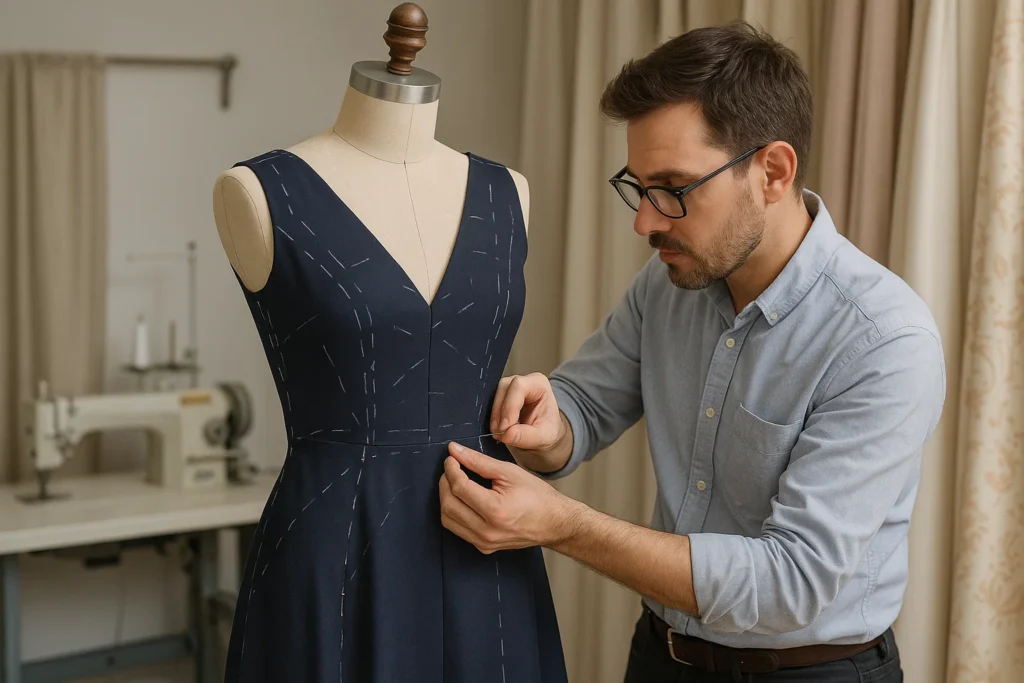Formal Dress Sewing Patterns: Designing the Perfect Fit with Expert Tailoring
- Home
- Style Tips
- Formal Dress Sewing Patterns: Designing the Perfect Fit with Expert Tailoring
Formal Dress Sewing Patterns: Designing the Perfect Fit with Expert Tailoring
A stunning gown starts long before the first stitch is made, it begins with the proper blueprint. The formal dress sewing patterns you choose determine how every seam falls, how fabric moves, and how the final silhouette takes shape. Yet many people discover too late that even the most beautiful fabric cannot save a dress cut from an unsuitable pattern.
It’s a common frustration. You find the perfect fabric for a special event, but the dress feels stiff, loose, or uncomfortable once finished. The issue usually lies not in the fabric but in the pattern’s design, proportions, or construction method. A proper pattern should complement your figure, support your movement, and align with your event’s formality.
At Precision Alterations in Phoenix and Tucson, our expert tailors transform ordinary patterns into extraordinary gowns. Whether you’re creating a custom evening dress, altering a wedding gown, or adjusting a pre-made pattern, precision in fit and technique makes all the difference. This guide explores how to select, sew, and refine formal dress sewing patterns to achieve a flawless, couture-inspired result that’s as comfortable as it is elegant.

Understanding Formal Dress Sewing Patterns
What Makes a Pattern “Formal”
Formal designs are defined by structure, symmetry, and sophistication. Formal sewing patterns differ from casual ones because they emphasize elegance, proportion, and movement. They often feature fitted bodices, lined interiors, intricate darts, and layered skirts. The pattern dictates how the dress holds its shape and how fabric interacts with the body under different lighting and motion.
The Purpose of Structure and Fit
A formal dress sewing pattern isn’t just a guide, it’s a foundation. Its lines and curves shape the garment’s architecture. The wrong proportions can make a luxury fabric appear unpolished, while accurate tailoring transforms even a simple textile into something remarkable. The best patterns incorporate shaping techniques such as princess seams, pleats, or bias cuts that flatter natural curves and add visual depth.
Choosing the Right Fabric for Your Pattern
The fabric must complement the pattern, not compete with it.
- Lightweight silks and chiffons flow beautifully for evening gowns or formal summer events.
- Satin and crepe offer structure for ballroom or gala looks.
- Velvet and brocade create depth for colder seasons and elegant indoor occasions.
Arizona’s warm climate calls for breathable, comfortable materials that retain polish under heat and movement. In Phoenix and Tucson, selecting the correct combination of pattern and fabric ensures elegance without discomfort.
From Paper to Precision
Every great design begins on paper but becomes exceptional through skill. Tailors use formal gown sewing patterns as a starting point, then refine them through professional techniques adjusting proportions, enhancing fit, and reinforcing key areas for strength and structure.
At Precision Alterations, we merge classic sewing craftsmanship with modern design understanding. Each alteration or pattern adjustment honors the original vision while ensuring the finished dress fits flawlessly. In later sections, we’ll explore how to choose the right pattern and why professional finishing like our professional sew-in methods for tailoring can elevate any project from handmade to high-fashion.
How to Choose the Right Pattern for Your Dress
Finding the right formal dress sewing patterns is about balancing design, fabric, and fit. A pattern that looks stunning on paper may not translate well if it doesn’t match your body type, sewing experience, or event style. The right choice saves time, enhances comfort, and ensures your final gown looks beautifully intentional.
1. Match the Occasion
Every formal event calls for a different kind of elegance.
- Weddings: Look for dress patterns for formal wear with flowing skirts and structured bodices. Fabrics like satin and organza elevate the design.
- Evening galas or dinners: Choose evening dress patterns with sleek silhouettes such as sheath or mermaid styles.
- Cocktail events: A-line or tea-length patterns strike a balance between formal and playful.
The goal is harmony let the design match the atmosphere of the event while maintaining comfort and grace.
2. Select the Silhouette for Your Shape
A great pattern accentuates what makes your shape unique.
- A-Line: Universally flattering, ideal for balance and flow.
- Sheath: Best for highlighting natural curves.
- Ball Gown: Classic and dramatic, perfect for formal weddings or galas.
- Empire Waist: Elegant and elongating, great for lightweight fabrics.
Expert tailors at Precision Alterations in Phoenix and Tucson can help you adapt your chosen pattern to your body’s proportions, ensuring that the dress fits perfectly while maintaining its intended design.
3. Understand Skill Level
Not all formal sewing patterns are beginner-friendly. Patterns featuring detailed boning, pleats, or fitted corsetry may require professional assistance. If you are new to sewing or working with luxury fabrics, consulting with an experienced seamstress can save both time and material.
4. Fit and Finishing Matter Most
Even a simple pattern can look stunning when properly fitted. Professional tailoring helps refine bust lines, adjust hemlines, and reinforce seams for long-lasting wear. Techniques such as professional sew-in methods including lining installation and hidden supports give a gown strength and smoothness. Learn more about these finishing details in our guide to professional sew-in methods for tailoring.

The Tailoring Process: Turning Patterns into Perfection
Tailoring transforms formal dress sewing patterns from flat designs into sculpted, wearable art. Every curve and seam is shaped around the wearer to achieve precision and grace. At Precision Alterations, each project follows a methodical process that blends technique and artistry.
Step 1: Consultation and Measurements
Everything begins with accurate measurements. The tailor assesses posture, shoulder slope, and body proportions to ensure perfect alignment. Precise measurements are the foundation for achieving balance and proportion in every dress.
Step 2: Fitting and Adjustments
Once the initial version of the dress is assembled, fittings begin. The tailor adjusts seams, hems, and darts to refine how the dress drapes and moves. This stage ensures the garment enhances the body’s shape while allowing natural comfort and mobility.
Step 3: Structure and Sew-In Methods
For formal gowns, structure defines elegance. Techniques such as adding linings, boning, interfacing, or underlayers are used to create durability and support. Our experts in Phoenix and Tucson employ advanced craftsmanship inspired by couture sewing traditions. You can read more about these finishing practices in our article on professional sew-in methods for tailoring.
Step 4: Final Finishing
The last stage involves pressing, hemming, and inspecting each seam. Details like invisible zippers, smooth linings, and reinforced edges guarantee that the finished gown looks as refined inside as it does on the outside. Every piece leaves our studio ready for life’s most memorable occasions.

Common Mistakes When Working with Formal Dress Patterns
Even skilled sewers encounter challenges when working with formal gown sewing patterns. Avoiding common errors saves fabric, time, and frustration.
- Choosing the wrong fabric: Heavy fabrics may overpower delicate designs. Lightweight materials might lack the structure for fitted silhouettes.
- Ignoring lining or understructure: These elements provide shape, strength, and polish.
- Skipping a test fit: A muslin mock-up allows you to correct issues before cutting your final fabric.
- Not adjusting for climate: Arizona’s warmth requires breathable materials and careful seam finishing to prevent bulk.
- Inaccurate measuring: A single inch can change how a gown sits on the shoulders or waist.
A professional tailor ensures precision at every stage, turning potential problems into beautifully fitted results.
Why Precision Alterations Is Arizona’s Trusted Tailoring Expert
- Personalized Service: Each client receives a consultation focused on style, comfort, and fabric selection.
- Expert Craftsmanship: Our team specializes in custom dress tailoring and complex formal sewing patterns for both Phoenix and Tucson clients.
- Attention to Detail: From luxury fabrics to precise seams, we ensure every gown reflects quality and care.
- Modern and Traditional Expertise: We blend hand-finishing techniques with advanced technology to create durable, elegant garments.
- Trusted Across Arizona: Brides, professionals, and event clients rely on us for gowns that feel flawless and look timeless.
At Precision Alterations, we see every dress as a collaboration between art and engineering. Your vision, paired with our tailoring expertise, creates a piece that lasts and impresses.

Conclusion: Elegance Designed to Fit You
Every stitch, seam, and line in a formal dress sewing pattern holds the potential for perfection. When guided by expert hands, that potential becomes reality. True tailoring ensures that your gown feels as beautiful as it looks, moving with you effortlessly and expressing your unique elegance.
At Precision Alterations in Phoenix and Tucson, we turn patterns into perfectly tailored masterpieces. From pattern selection to final fitting, our tailors bring precision, creativity, and craftsmanship to every design. Bring your fabric, your pattern, and your vision and let us create the perfect formal dress designed just for you.
Frequently Asked Questions
- What are formal dress sewing patterns?
They are structured templates used to create elegant gowns, featuring defined seams, lining, and shaping elements that ensure professional results. - How do I choose the right pattern for a formal dress?
Consider the event, your skill level, and the fabric type. A-line, sheath, and mermaid patterns are versatile options for most body types. - Can beginners sew formal dresses?
Yes, but professional guidance helps. Tailors at Precision Alterations can refine your pattern and assist with advanced finishing techniques. - What fabrics are best for formal dresses in Arizona?
Lightweight satin, silk, and chiffon are ideal for warmer climates like Phoenix and Tucson, while velvet and brocade work well for cooler months. - Where can I get professional help for my dress pattern?
Visit Precision Alterations in Phoenix or Tucson for expert fitting, pattern adjustments, and couture-level finishing.
For those looking to complete their look with an affordable, high-quality suit, visit our partner company Van Allan’s Men’s Fashion, proudly serving Phoenix with timeless style and exceptional craftsmanship.
SUBSCRIPTION
Subscribe to our newsletter
Store Hours Phoenix
Monday – Friday
10:00am – 06:00pm
Saturday
10:00am – 04:00pm
Sunday
Off
Tucson Store Hours
Monday – Saturday
09:00am – 07:00pm
Sunday
11:00am – 05:00pm
Contact Us
- +602 2750599
- precisionalterations@yahoo.com
- Arcadia Crossing 4539 E. Thomas Road, Suite 104, Phoenix, AZ 85018
